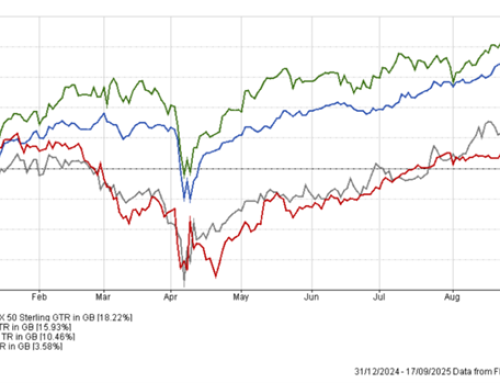The U.S. stock market has risen by over 25% since the 8th April, reaching a new all-time high. The rally began when President Trump announced a deferral of the tariffs he had introduced on the 2nd April. However, the significance of this move seems to have been lost on President Trump, who remarked that he thinks the tariffs have been well received and noted the stock market’s record high.
These comments came in an interview with NBC, during which he floated the idea of imposing 15% or 20% blanket tariffs on “all the remaining countries.” It’s unclear which countries he was referring to. Some media outlets have speculated that he means replacing the baseline 10% rate with a higher rate of 15% to 20%. However, it seems more likely that he means those countries who had deferred tariff rates but haven’t received a letter. The latter explanation seems more plausible, as the Trump administration seems to have reached far fewer trade agreements than it had expected during the 90-day deferral period. Instead, most countries are expected to receive letters, some of which were sent out early this month.
However, at the time of writing, the majority of countries have neither received a letter nor reached a deal, and the 90-day deferral period has now expired.
Also this month, additional punitive tariffs were announced on Canada and Mexico, with goods not already covered by the United States-Mexico-Canada Agreement (USMCA) now subject to 35% or 30% tariffs respectively.
Brazil attracted the president’s ire for pursuing a conviction against former President Bolsonaro. President Trump described the charges as a “witch hunt” and responded by imposing a 50% tariff on Brazil. Additionally, several other countries have received individual tariff letters. In most cases, these tariffs are close to the previous individual rates, although those rates were only in effect for a matter of hours before being deferred for 90 days.
The European Union continues to try and find a deal, but if it’s unsuccessful, President Trump announced that it would face a 30% tariff, an unusual 10%-point increase on the ‘Liberation Day’ rate.
The president has also begun announcing the results of sector-specific tariffs, including a 50% tariff on copper imports. The U.S. currently imports roughly half the copper it needs, as domestic production has been declining. While the tariff could help to reverse that trend, it can take between five and ten years to bring a copper mine from conception to production. In the meantime, the copper import tax is expected to increase costs for U.S. industries such as construction, electronics, automobiles, renewable energy and data centres
UK starts to feel tax pressures
UK gross domestic product (GDP) data released this month revealed that the economy contracted again in May, defying forecaster expectations of a rebound following April’s decline. UK GDP growth has been stifled by a few forces. Tax increases in April, including a rise in National Insurance, contributed to the contraction, and will likely have a lasting impact. An effective increase in stamp duty pulled some housing transactions forward into the first quarter, while exports to the U.S. were also brought forward to get ahead of tariffs.
The UK economy has been slow to recover its momentum. June data should be better, though, with positive momentum rebuilding in trade after the earlier shocks this year. Nonetheless, weak growth makes an August interest rate cut increasingly likely. Lower interest rates would be very welcome, as they play a large role in determining whether the public finances stay within the chancellor’s fiscal rules, or whether tax increases are needed this autumn.
Other viewpoints
Cash
Interest rates held steady at 4.25%, but expectations of further cuts persist. Instant access savings rates remain around 4.4%, while fixed-term rates have dipped slightly. Analysts now expect rates to fall to 3.5% by year-end, with some forecasting 3.0% in early 2026. UK inflation remains subdued, supporting the case for gradual easing.
Fixed Interests
UK gilt yields declined modestly, with 10-year yields hovering near 4.6%, reflecting softer macro data and political uncertainty. The US bond market rallied, driven by falling Treasury yields and expectations of Fed rate cuts. Credit spreads narrowed slightly, with investment-grade bonds outperforming high-yield.
Alternatives
Gold prices rose 0.4% in July, recovering from June’s dip amid renewed central bank buying and geopolitical jitters. Silver outperformed, surging 9.5%, catching up with gold’s earlier rally. Oil prices remained volatile, spiking mid-month due to Middle East tensions before retreating to $69/barrel following a ceasefire between Israel and Iran.
UK Shares
The FTSE 100 hit a record high of over 9,000, buoyed by easing trade tensions and strong performance in banking and industrials. Despite weak April GDP data, investor sentiment improved as inflation remained stable and interest rate cuts are anticipated. Unemployment rose to 4.6%, but wage growth slowed, easing pressure on the Bank of England.
US Shares
The S&P 500 and Nasdaq Composite reached new highs, driven by robust earnings and AI optimism. Nvidia became the world’s first $4 trillion company, fuelling tech sector gains. However, stretched valuations and renewed tariff threats from President Trump have prompted caution among portfolio managers.
European Shares
European markets posted modest gains, with the DAX 40 hitting an all-time high. The ECB cut rates to 2%, its eighth consecutive cut, aiming to support growth amid weak consumer confidence and slowing inflation.
Asian Shares
Asian equities rallied, led by Hong Kong and Japan. The Hang Seng Index climbed high, boosted by a US-China trade deal and easing tariffs. China’s retail sales improved, but factory output slowed. India’s markets remained strong, supported by domestic demand and foreign inflows.
Emerging Markets
Emerging markets rebounded, helped by a weaker US dollar and stabilising commodity prices. Central banks in Latin America and Asia signalled rate cuts, while investor appetite returned to tech and energy exporters. However, political risks and inflation concerns continue to weigh on sentiment.

